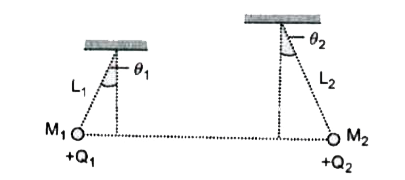Statement I: Stopping potential depends upon the frequency of incident light but is independent of the intensity of the light.
Statement II: The maximum kinetic energy of the photoelectrons is proportional to stopping potential.Solution in Kannada
A. Statement-I is false, statement-II is true.
Statement-I is true, statement-II is false.
Statement-I is true, statement-II is true. Statement-II is correct explanation of statement-I
Statement-I is true, statement-II is true and statement - II is not correct explanation of statement-I.
The correct Answer is:A
Step by step video, text & image solution for Statement I: Stopping potential depends upon the frequency of incident light but is independent of the intensity of the light. Statement II: The maximum kinetic energy of the photoelectrons is proportional to stopping potential. by Physics experts to help you in doubts & scoring excellent marks in Class 12 exams.
Topper's Solved these Questions
- BOOK - MODERN PUBLICATIONCHAPTER - ELECTRONS & PHOTONSEXERCISE - MULTIPLE CHOICE QUESTIONS (LEVEL-II)63videos
ELECTRONS & PHOTONS
- BOOK - MODERN PUBLICATIONCHAPTER - ELECTRONS & PHOTONSEXERCISE - MULTIPLE CHOICE QUESTIONS (LEVEL-III)9videos
ELECTRONS & PHOTONS
- BOOK - MODERN PUBLICATIONCHAPTER - ELECTROMAGNETIC WAVESEXERCISE - RECENT COMPETITIVE QUESTIONS4videos
ELECTROMAGNETIC WAVES
- BOOK - MODERN PUBLICATIONCHAPTER - ELECTROSTATICSEXERCISE - RECENT COMPETITIVE QUESTIONS39videos
ELECTROSTATICS
Similar Questions
Maximum frequency of the photon produced by the union of a proton and a antiproton is (given : mp=1.67×10−27kg):
01:34View SolutionEnergy required for the electron excitation in Li++ from the first to the third Bohr orbit is :
05:11View SolutionThe speed of electromagnetic wave in vacuum depends upon the source of radiation
03:30View SolutionTwo small spheres of masses M1andM2 are suspended by weightless insulating threads of lengths L1andL2 The spheres carry charges Q1andq2 respectively . The spheres are suspended such that they are in level with one another and the threads are inclined to the vertical at angles of θ1andθ2 as shown . Which one o fthe following conditions , if θ1=θ2 ?
 03:58View Solution
03:58View SolutionAssertion : The stopping potential depends on the frequency of incident light.
Reason : The stopping potential is related to maximum kinetic energy by eV0=Kmax.02:58View SolutionAssertion: Stopping potential depends upon the frequency of incident light but is independent of the intensity of the light. Reason :The maximum kinetic energy of the photoclectrons is proportional to stopping potential
04:08View SolutionStatement I: In photoelectric effect the value of stopping potential is not at all dependent on the wavelength of the incident light.
Statement II: The maximum kinetic energy of the emitted photoelectron and stopping potential are proportional to each other.05:53View SolutionWhat is meant by stopping potential in photoelectric emission ? Does the stopping potential depend on (i) the intensity and (ii) the frequency of the incident light ? Explain
View SolutionIf the frequency of light in a photoelectron experiment is doubled the stopping potential will
01:35View SolutionStatement I A metallic surface is irradiated by a monochromatic light of frequency v gt v_(0) ( the threhold frequency ). The maximum kinetic energy and the stopping potential are K_("max") and V_(0) respectively. If the frequency incident on the surface is doubled, both the K_("max") and V_(0) are also doubled. Statement II The maximum kinetic energy and the stopping potential of photoelectrons emitted from a surface are linearly dependent on the frequency of incident light.
01:29View Solutionप्रकाश -विधुत उत्सर्जन में किया निरोधी विभव निर्भर करता है -
(i) फोटो पर आपतित प्रकाश की तीव्रता पर ?
(ii) आपतित प्रकाश की आवृत्ति पर ?05:31View SolutionDoes the 'stopping potential' in photoelectric emission depend upon
(i) the intensity of the incident radiation in a photocell. ?
(ii) The frequency of the incident radiation ?View SolutionValue of stopping potential depends on……. Of incident light.
02:14View SolutionA:Value of stopping potential depend on frequency of incident light and independent of intensity of light.
R:Maximum kinetic energy of photoelectron is proportional to stopping potential .04:19View Solutionकथन : प्रकाश विद्युत प्रभाव में निरोधी विभव पर प्रकाश इलेक्ट्रान का उत्सर्जन रुक जाता है|
कारण : आपतित प्रकाश की तीव्रता में वृद्धि फोटो इलेक्ट्रान की गतिज ऊर्जा को बड़ा देती है|01:44View Solution

